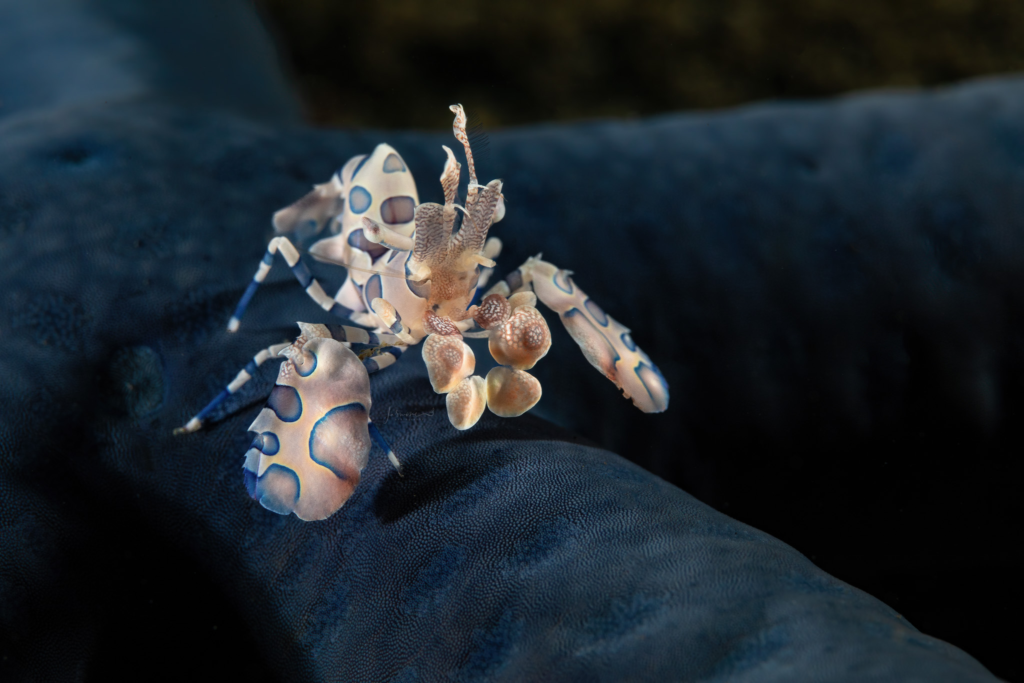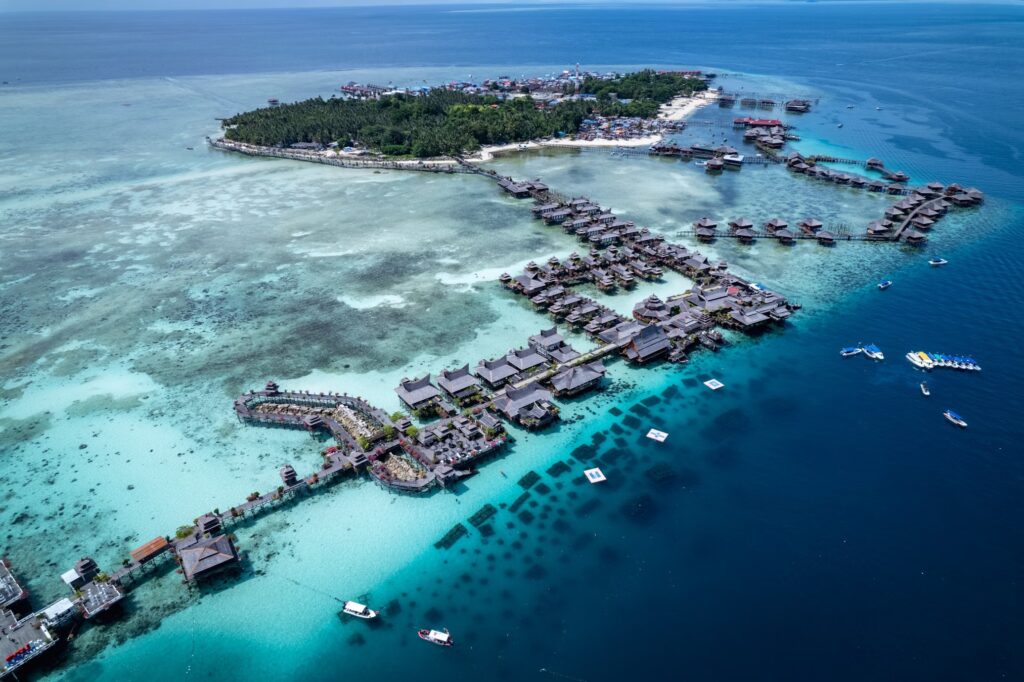Tiny, yet captivating, the harlequin shrimp is one of the ocean’s most dazzling invertebrates. Highly prized by divers and photographers due to its striking colours and unique behaviour, spotting one can make any dive unforgettable.
To help you get started, we’ve created this complete guide to harlequin shrimps, where you can learn more about their behaviour, the best dive spots to find them, and photography tips to capture their stunning beauty!
Get to Know the Harlequin Shrimp

The harlequin shrimp, also known as the Hymenocera picta, is a species of saltwater shrimp most commonly known for its striking appearance. They typically have blue-edged red and purple dots adorning their cream-coloured body and paddle-like claws. Their vivid patterns and fascinating behavior make them one of the most eye-catching sea critters for macro diving.
Harlequin Shrimp Size
The harlequin shrimp size ranges from 2,5 to 5 cm (1-2 inches). The females have a slightly larger body than the males.
Habitat and Location
Harlequin shrimps live in the coral reefs and rocky areas in the tropical Indian and Pacific Oceans. Known for being monogamous, harlequin shrimps are usually found in pairs, so you’ll hardly spot them being alone.
Harlequin Shrimp Diet and Feeding Habits
Another fascinating aspect of these shrimps is their diet. They are very efficient predators, feeding exclusively on starfish. Harlequin shrimps use their pincers to turn the starfish over, rendering them immobile, and slowly consuming their tissue.
Best Places to Find Harlequin Shrimps
1. Indonesia

Indonesia, with its warm waters and diverse underwater ecosystem, provides the ideal habitat for harlequin shrimps to thrive. This country is a part of the Coral Triangle, a special marine region renowned for its extraordinary biodiversity, hosting over 75% of the world’s coral species and thousands of marine life forms.
Top Dive Spots:
- Lembeh Strait: Lembeh Strait is one of the world’s most iconic muck diving destinations, celebrated for its incredible macro biodiversity. Shrimps thrive along its sandy slopes and coral rubble, alongside other rare and remarkable critters.
- At Solitude Lembeh Resort, our dive guides are eager to help you uncover these tiny treasures, turning every dive into a fascinating search through the muck.
- Ambon: Located in the Maluku Islands, Ambon is an underrated muck diving spot. Its waters are rich in nutrients, and various elusive critters thrive in its sandy bottoms. What’s more, you can enjoy a calmer, quieter dive in Ambon, as it has less crowd.
- Tulamben: Tulamben is one of the best dive sites in Bali for spotting harlequin shrimps. This area has volcanic black sands, which provide a good habitat for these shrimps. The waters in Tulamben are also calm with excellent visibility, making it great for macro photography.
2. Papua New Guinea

Also a part of the Coral Triangle, Papua New Guinea(PNG)is a great hotspot for marine biodiversity. It also boasts several muck diving spots in remote locations, ensuring the environment remains pristine and largely untouched.
Top Dive Spots:
- Milne Bay: Milne Bay is a top muck diving spot in PNG. It offers an abundance of rare and fascinating macro life. Its pristine coral also provides the perfect home for harlequin shrimps.
- Kimbe Bay: Another dive spot in PNG with healthy reefs and an abundance of marine creatures, Kimbe Bay is a paradise for macro photographers. Aside from the shrimps, you can also find other critters, such as nudibranchs and frogfish.
3. The Philippines

With an abundance of pristine coral reefs and starfish, the Philippines is one of the best dive sites to spot the harlequin shrimps. The waters in this region are warm with great visibility, and there are several fantastic macro dive sites to visit.
Top Dive Spots:
- Anilao: Anilao is famed as the macro diving capital of the Philippines—an ideal haven for shrimp lovers. Coral rubble and starfish-laced seabeds create the perfect home for countless species, alongside nudibranchs, mimic octopuses, and frogfish.
- At Solitude Acacia Resort, our dive guides are always excited to help you spot these elusive wonders. With their sharp eyes and local know-how, each dive becomes a critter-hunting adventure. Dive by dive, Anilao reveals its secrets—and we’re here to share them with you.
- Malapascua: Malapascua, an island in Cebu, is known for its consistent harlequin shrimp spotting. In addition, this area is also known for encounters with pelagic species, including manta rays and thresher sharks.
- Puerto Galera: Located on Mindoro Island, Puerto Galera offers plenty of opportunities to spot harlequin shrimps and other sea creatures, making it a destination worth checking out.
4. Malaysia

Malaysia, particularly near the Sabah region, is a good place to go scuba diving with harlequin shrimp. This is because the Sabah region is located within the Coral Triangle, so you’ll be sure to find a remarkable marine biodiversity there.
Top Dive Spots:
- Mabul Island: Located off the coast of Sabah, Mabul Island is one of the best places to go if you wish to find these crustaceans. The island has several muck dive sites, where you can find all sorts of creatures hidden in the coral crevices.
Underwater Photography Tips for Harlequin Shrimps
Harlequin shrimps are among the most visually striking critters you’ll encounter on a dive. They are the kind of macro subject underwater photographers dream of. If you’re lucky enough to spot one, here’s how to capture it at its best—plus, don’t miss our underwater photography guide for beginners to help sharpen your skills.
1. Know Their Habitat
The harlequin shrimps are typically found in coral reefs, usually under ledges or within small crevices. Research locations where they are most commonly spotted so you can find them quicker and easier.
2. Use the Right Gear
To get the best pictures, always make sure that you bring the right gear for your dive. In general, you’ll want to use a 60mm lens to get good picture quality. However, a 100mm or 105mm lens can be more reliable if you want to blur out the background, particularly for areas like small crevices. A fisheye lens or compact cameras can be great alternatives, as they can provide a different, creative perspective.
3. Pay Attention to Lighting and Exposure
Though they are colourful, harlequin shrimps can be a bit hard to photograph because of the white, reflective parts of their bodies. If you aren’t careful with the lighting and angles, you might blur out the details on their bodies.
Because of this, you need to pay attention to your strobe light and exposure. Focus on the brightest part of the shrimp, usually their claws or body. In addition, a side angle or profile view can help reduce bright spots reflecting off the shrimp’s body.
You can also focus on the shrimp’s eye for a more captivating shot. If your camera lets you choose the focal point, position it where the eye will appear in the frame. Then, compose your shot with the focal point directly on the nearest eye. Steady buoyancy is crucial since their eyes are so small!
4. Capture Their Behaviour
These shrimps typically only feed on starfish and their unique feeding behavior can be a great object for underwater photography. Capturing their behaviour can make your pictures look more natural and unique.
However, remember to be mindful of your distance and position. These creatures are generally not easily startled, but you still have to be careful to avoid disrupting their behaviour and environment.
Let’s Meet More Unique Marine Creatures with Solitude World’s Liveaboard and Resorts!

Ready to start your scuba diving trip and meet unique ocean creatures? If yes, plan your next diving journey with Solitude World’s Liveaboard and Resorts!
We offer liveaboard dive trips that can take you to some of the best diving spots in Indonesia, the Philippines, and Palau. PADI-certified guides will also be present on our vessels to ensure that you have a safe and enjoyable dive. Afterwards, once you’re done with your underwater excursion, you can return to a tidy, cozy room to rest and rejuvenate your body.
If you prefer land-based accommodations, we have dive resorts in prime muck diving sites in the Philippines (Solitude Acacia) and Indonesia (Solitude Lembeh). Underwater photography workshops led by experts are also available in our resorts, along with dedicated camera rooms to safely store your gear and equipment.
What are you waiting for? Book your stay at Solitude Liveaboards and Resorts today!